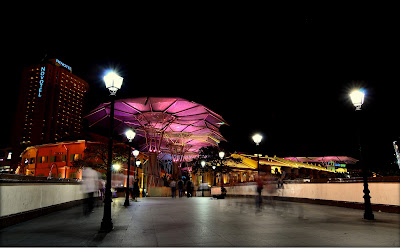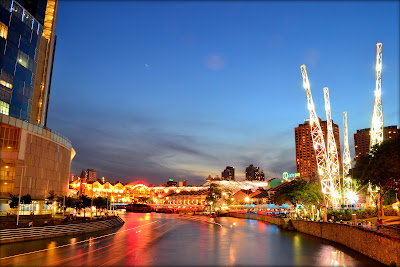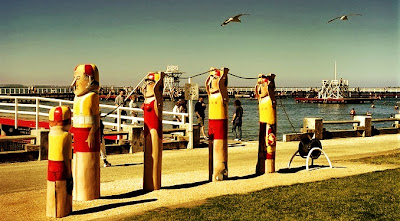 |
| SUZHOU » one of over 100 new Chinese cities now being built or planned |
In
my previous blog, I responded to the question asked by a planner I met in China
about whether destination character can be planned for a new city. I used
Geelong as a case study to illustrate the two universal elements I believe are
crucial for building destination character – designing a Destination Personality and designing Destination Experiences.
In
this blog, I’ll jump straight to a case study close to my heart – the
revitalisation of the Singapore River and Marina Bay district – which was a
project I worked on several years ago.
The
historic Singapore River was once the bustling heart of Singapore, but decades
of overcrowding and pollution prompted the government to clean up the area in
the 1980s and 90s. After a major
makeover by the Urban Redevelopment Authority with new bridges, footpaths,
lighting etc – the precinct looked brand new and ready for a new lease on life. However, despite businesses moving back into
the area, this precinct still lacked soul. And so, the Singapore Tourism Board in
partnership with the Urban Redevelopment Authority and local businesses set
about to revitalise the district, and again attract visitors and locals alike
to this mixed use recreational precinct.
Below
are some of the features used to enhance the destination character and bring
the area back to life.
Case study #2: THE SINGAPORE
RIVER DISTRICT, Singapore
Description: Singapore’s inner-city playground » historical precinct revitalised with an
eclectic mix of bars, clubs, restaurants, leisure, retail, tourist attractions,
office and residential development
Destination personality: Playful, fresh outlook with a rich heritage
past, ever-changing
Iconic destination
experiences: Exploring places of interest along the
continuous riverside promenades that pass through the heritage areas of
Robertson Quay, Clarke Quay, Boat Quay, and the ultra-modern Marina Bay.
Distinctive design features that reflect the destination personality:
»
Land use planning and spatial design that concentrated recreational activities (something to see and do) along the entire length of the river – with
“active” landuses (pubs, restaurants, retail etc) and breakout spaces thoughtfully
designed along both banks of the river so that there are no “dead spots”.
»
Life-sized sculpture series to visually
depict the heritage stories of people who once lived, worked and played
along this historic waterway.
 |
| Jumping Boys » from the past when it was not uncommon to see naked boys swinging from trees beside the river and jumping into the water |
 |
| A Great Emporium » when Singapore River was a busy trading port |
 |
| From Chettiars to Financiers» a contemporary nod to the past |
»
Intentional contrasting mix of “old and
new” design features (heritage features and post-modern designs)
incorporated into a variety of pedestrian-level touch points along the entire length of the river » street
furniture, pavement design, street art, water transportation (bum boats), lighting, signage etc
»
Activation of the most visually prominent feature – the waterway – by
re-introducing heritage bum boats that now ferry visitors and locals up and
down the river. Water transportation was an important feature to create movement both day and night, theatrically designed to give the effect of constant activity
along the entire length of the river.
 |
| Iconic bumboats » a direct link to the heritage of Singapore River |
»
Hierarchy of open spaces and breakout
spaces along regular intervals of the promenade that catered to a range of
event sizes. Events and recreational
activities were considered crucial for adding
to the effect of constant activity along the entire length of the river.
 |
| Multi-purpose breakout space » Read Bridge, Clarke Quay |
 |
| Multi-purpose breakout space » Raffles Landing Site, Boat Quay |
»
Sensitive and location-appropriate
theming of each quay or precinct (e.g. each quay has its own suite of street
furniture, lighting etc) to create a
sense of discovery as people walk up and down the riverside
promenades. This was designed to avoid a
sense of monotony, and to encourage people to explore other parts of the river.
 |
| Foreground: Boat Quay | Background: Marina Bay |
 |
| Clarke Quay » nightlife precinct |
»
Careful attention was given to the continuous
lighting of the river, given that most people visit during the evenings. Concepts included the lighting of bridges,
bumboats, architectural features, approaches to the river, festive lighting and
treatment of special elements. These
lighting features add to the effect of
movement and activity, and beckon
visitors to explore other parts of the river.
 |
| Lighting of bridges » Elgin Bridge |
.JPG) |
| Lighting of the riverbank, architectural features and street furniture |
 |
| Clarke Quay » nightlife precinct |
»
Pedestrian comfort - achieved with
landscaping, shading, lighting, wide promenades, quality street furniture,
breakout spaces etc - was of paramount importance to encourage visitors to stay longer and explore more of the river
district.
 |
| Landscaping for shading and character » Empress Place |
 |
| Covered walkways for protection from the sun and rain » Clarke Quay |
This is the second of a three-part blog, with another post to uploaded over the coming weeks.
Click on any of the “subscribe” links if you’d like to be informed of when
the next post is uploaded.













